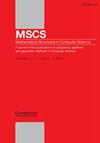E-Unification based on Generalized Embedding
IF 0.9
4区 计算机科学
Q4 COMPUTER SCIENCE, THEORY & METHODS
引用次数: 1
Abstract
Ordering is a well-established concept in mathematics and also plays an important role in many areas of computer science, where quasi-orderings, most notably well-founded quasi-orderings and well-quasi-orderings, are of particular interest. This paper deals with quasi-orderings on first-order terms and introduces a new notion of unification based on a special quasi-order, known as homeomorphic tree embedding. Historically, the development of unification theory began with the central notion of a most general unifier based on the subsumption order. A unifier $\sigma$ is most general, if it subsumes any other unifier $\tau$ , that is, if there is a substitution $\lambda$ with $\tau=_{E}\sigma\lambda$ , where E is an equational theory and $=_{E}$ denotes equality under E. Since there is in general more than one most general unifier for unification problems under equational theories E, called E-Unification, we have the notion of a complete and minimal set of unifiers under E for a unification problem $\varGamma$ , denoted as $\mu\mathcal{U}\Sigma_{E}(\Gamma)$ . This set is still the basic notion in unification theory today. But, unfortunately, the subsumption quasi-order is not a well-founded quasi-order, which is the reason why for certain equational theories there are solvable E-unification problems, but the set $\mu\mathcal{U}\Sigma_{E}(\Gamma)$ does not exist. They are called type nullary in the unification hierarchy. In order to overcome this problem and also to substantially reduce the number of most general unifiers, we extended the well-known encompassment order on terms to an encompassment order on substitutions (modulo E). Unification under the encompassment order is called essential unification and if $\mu\mathcal{U}\Sigma_{E}(\Gamma)$ exists, then the complete set of essential unifiers $e\mathcal{U}\Sigma_{E}(\Gamma)$ is a subset of $\mu\mathcal{U}\Sigma_{E}(\Gamma)$ . An interesting effect is that many E-unification problems with an infinite set of most general unifiers (under the subsumption order) reduce to a problem with only finitely many essential unifiers. Moreover, there are cases of an equational theory E, for which the complete set of most general unifiers does not exist, the minimal and complete set of essential unifiers however does exist. Unfortunately again, the encompassment order is not a well-founded quasi-ordering either, that is, there are still theories with a solvable unification problem, for which a minimal and complete set of essential unifiers does not exist. This paper deals with a third approach, namely the extension of the well-known homeomorphic embedding of terms to a homeomorphic embedding of substitutions (modulo E). We examine the set of most general, minimal, and complete E-unifiers under the quasi-order of homeomorphic embedment modulo an equational theory E, called $\varphi U\Sigma_{E}(\Gamma)$ , and propose an appropriate definitional framework based on the standard notions of unification theory extended by notions for the tree embedding theorem or Kruskal’s theorem as it is called. The main results are that for regular theories the minimal and complete set $\varphi\mathcal{U}\Sigma_{E}(\Gamma)$ always exists. If we restrict the E-embedding order to pure E-embedding, a well-known technique in logic programming and term rewriting where the difference between variables is ignored, the set $\varphi_{\pi}\mathcal{U}\Sigma_{E}(\Gamma)$ always exists and it is even finite for any theory E.基于广义嵌入的e -统一
排序在数学中是一个公认的概念,在计算机科学的许多领域也起着重要的作用,其中准排序,特别是有充分根据的准排序和良好的准排序,是特别感兴趣的。本文讨论了一阶项上的拟序,并引入了一种新的基于一种特殊的拟序的统一概念,即同胚树嵌入。历史上,统一理论的发展始于一个基于包容秩序的最普遍统一者的中心概念。一个统一子$\sigma$是最一般的,如果它包含任何其他统一子$\tau$,也就是说,如果用$\tau=_{E}\sigma\lambda$替换$\lambda$,其中E是一个方程理论,$=_{E}$表示E下的相等性,因为在方程理论E下的统一问题通常有不止一个最一般的统一子,称为E-统一,对于统一问题$\varGamma$,我们有E下统一器的完备最小集的概念,记为$\mu\mathcal{U}\Sigma_{E}(\Gamma)$。这个集合在今天仍然是统一理论的基本概念。但是,不幸的是,包含拟序并不是一个建立良好的拟序,这就是为什么某些方程理论存在可解的e -统一问题,而集合$\mu\mathcal{U}\Sigma_{E}(\Gamma)$不存在的原因。在统一层次结构中,它们被称为nullary类型。为了克服这一问题,也为了大大减少大多数一般统一子的数量,我们将众所周知的项上的包涵顺序推广到替换上的包涵顺序(模E)。包涵顺序下的统一称为本质统一,如果$\mu\mathcal{U}\Sigma_{E}(\Gamma)$存在,则本质统一子的完备集$e\mathcal{U}\Sigma_{E}(\Gamma)$是$\mu\mathcal{U}\Sigma_{E}(\Gamma)$的一个子集。一个有趣的结果是,许多具有无限个最一般统一子集的e -统一问题(在包含阶下)简化为只有有限个基本统一子的问题。此外,在等式理论E的某些情况下,大多数一般统一子的完备集不存在,但是存在基本统一子的极小和完备集。不幸的是,包涵序也不是一个有充分根据的拟序,也就是说,仍然存在具有可解的统一问题的理论,对于这些理论,基本统一子的最小和完全集合是不存在的。本文讨论了第三种方法,即将众所周知的同胚嵌入项推广到替换的同胚嵌入(模E)。我们研究了同胚嵌入模E的准阶下的最一般、最小和完全E统一子集合,称为$\varphi U\Sigma_{E}(\Gamma)$。并提出了一个合适的定义框架,该框架基于统一理论的标准概念,由树嵌入定理或Kruskal定理的概念扩展。主要结果是:对于正则理论,极小集和完备集$\varphi\mathcal{U}\Sigma_{E}(\Gamma)$总是存在的。如果我们将E-嵌入顺序限制为纯E-嵌入,这是一种众所周知的逻辑编程和项重写技术,其中变量之间的差异被忽略,集合$\varphi_{\pi}\mathcal{U}\Sigma_{E}(\Gamma)$总是存在的,甚至对任何理论E都是有限的。
本文章由计算机程序翻译,如有差异,请以英文原文为准。
求助全文
约1分钟内获得全文
求助全文
来源期刊

Mathematical Structures in Computer Science
工程技术-计算机:理论方法
CiteScore
1.50
自引率
0.00%
发文量
30
审稿时长
12 months
期刊介绍:
Mathematical Structures in Computer Science is a journal of theoretical computer science which focuses on the application of ideas from the structural side of mathematics and mathematical logic to computer science. The journal aims to bridge the gap between theoretical contributions and software design, publishing original papers of a high standard and broad surveys with original perspectives in all areas of computing, provided that ideas or results from logic, algebra, geometry, category theory or other areas of logic and mathematics form a basis for the work. The journal welcomes applications to computing based on the use of specific mathematical structures (e.g. topological and order-theoretic structures) as well as on proof-theoretic notions or results.
 求助内容:
求助内容: 应助结果提醒方式:
应助结果提醒方式:


